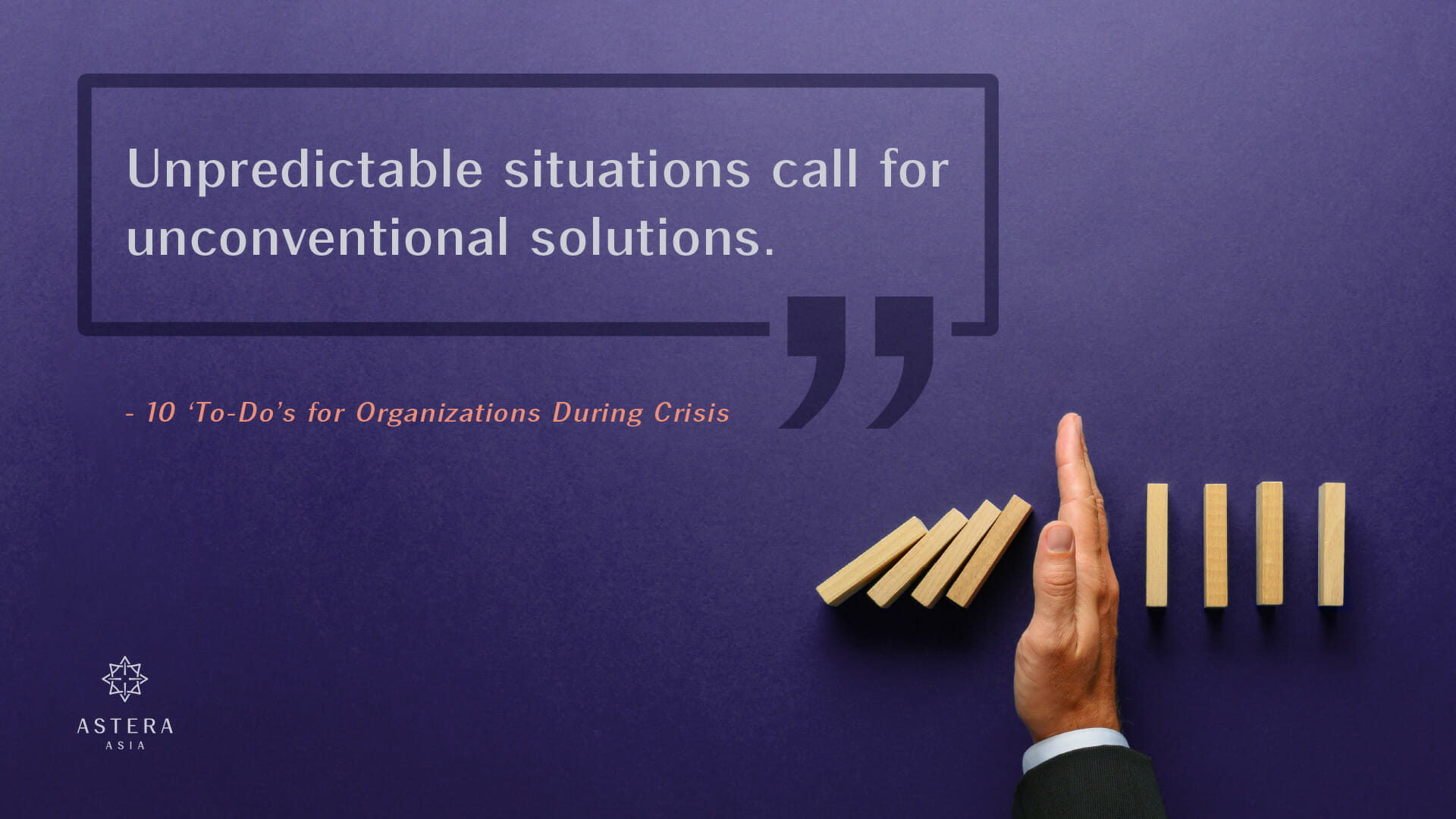In times of crisis, business is not as usual. Challenging times are an inevitable part of every organization’s life (for-profit or not). Yet, we also know that seasons of crisis do not last forever. So, what can we do during these messy times, and how can we prepare well for when they eventually pass?
When faced with the unexpected, our natural reaction is to fight the most immediate fires. While that is necessary, it may distract us from protecting our organizations/businesses in a holistic manner. Sometimes, the most important parts are overlooked, parts that—if addressed first—could prevent further fallout from taking place.
The following are ten things organizations can do in a crisis to best weather the storm while strengthening and readying for recovery.
1. Buy time
‘Time’ is the greatest asset in a crisis, not money. Time allows for external variables to play themselves out and gives the space to make calm, thought-through decisions. Money is one way of buying time but not the only way. Take an in-depth look at all aspects of the organization and see where conservation is possible. Operationally, consider ways to reduce and slow down. Leave no stone unturned. Every little bit helps and adds up to significant breathing space for the organization.
2. Establish a protocol
Emergency protocols, like first aid kits, should be developed before they’re needed. If you don’t have one already, putting one together now is still better than not having one at all. Protocols help shift the organization’s mode from panic to preparedness by setting guidelines and increasing visibility. A protocol should include objectives, considerations for all stakeholders, and should be mapped out in phases over time. A protocol will also help to steady your team, giving them confidence that the organization has an approach, even in the midst of unknowns.
3. Conduct a health check
While funding is important, it also does a good job of hiding inherent operational problems and weaknesses. There may be age-old deficiencies that have been ignored out of busyness or didn’t seem that important because there was enough funding to buffer. Though we would never wish crisis on an organization, seasons of lack are often a test of an organization’s true strength. When money is low, problems boil to the surface. Many of these problems, surprisingly, have little to do with money. Now is the time to work through these issues, patch up the holes, and get healthy. When funding returns, you’ll be in a much better position to manage your resources effectively.
4. Resist hasty decisions
Crisis pressures us to act, especially when we see others doing it. “We have to do something, anything!” False. Now is not the time for emotional, knee-jerk reactions, especially ones that lead to significant change or impact other people. The last thing you need is an impulsive decision that will birth a hundred new problems, requiring the very resources that you are working hard to conserve. During a crisis, much is unknown, but not all. Focus on the things you are sure of and navigate from there. If you’re not sure, it is better to wait.
5. Communicate
Organizations should only communicate when things are certain or solved, right? If you’re not sure, why say it? Because silence is worse. If you don’t set the narrative, it will be set for you. You don’t want that. Even if you don’t have everything figured out, let your stakeholders know you’re working on it. There will always be tension between over-communicating and under-communicating. Establishing clear, single-minded messages, true to your organization’s voice, and presenting them in a succinct and professional manner will help strike that balance more easily. Ultimately, strong, well-timed communications will provide reassurance to everyone involved.
6. Read your surroundings
Whether we like it or not, the environment around us is going to shake up our plans. The difference will be whether the unexpected finds us ready or catches us off guard. There are many external factors at play that impact and influence big and small organizations alike. It would be foolish to ignore trends and changes in your sector, industry, government, and economy, especially in a crisis. The organizations that emerge from crisis the strongest are the ones that were watching, interpreting the market, and began evolving before it was necessary.
7. Avoid isolation
No organization is an island. Distancing measures during crisis should not stop us from interacting. Now—more than ever—we need to be listening and learning from each other, even from our competitors! We need to be exploring creative ways to collaborate, leveraging resources, and sharing insight. Remember that you’re not in this alone. Many people have the same questions and concerns as you. While others who are further along than you may have already found solutions. Resources are limited as it is, let’s help each other out. It’s the only way we will get through it together.
8. Go back to the basics
Take a step back, grab a coffee, and relook at your vision, mission, and value proposition. Remind yourselves what you’re good at, why you’re here in the first place, and hold fast to it. Focusing on core strengths will help eliminate less productive activities, which in turn, conserves resources and buys time. In addition to its operational benefits, this exercise is also a helpful way to encourage your team and boost morale. Turning attention back to your passion and commitment has a unifying effect.
9. Adapt your strengths
This point does not contradict the previous, but builds upon it. Once you have reaffirmed your strengths, find new and creative ways to deliver those strengths within the confines of the crisis environment. Now is not the time for a brand new product that requires a ton of research and resources so that you can enter an unexplored market. Now is the time to focus on what you do best and adapting it. Take what is tried-and-true and find new people who need it or alternative ways to use it.
10. Use time wisely
Downtime is often seen as an organizational negative. And while we would never choose it, we all wish we had it. Now we do. Downtime is necessary. Clear out the closet, refine policies and processes, retool your team, keep skills sharp. Do all the things on your ‘when there’s time’ list. Because recovery will come, and when it does, you’ll want to be prepared. You’ve worked hard to buy time, now use it well. You’ll be glad you did.
Unpredictable situations call for unconventional solutions, and everyone can use help. If you’re unsure of how to navigate your organization through a turbulent time or how best to communicate with those who need to hear from you, let us know. We’re here to help.





